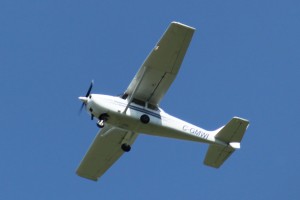Oops, Wrong Rudder…

In Plan D, I described my long solo cross country flight. After that, it was just a matter of improving the consistency of my performance in all the required maneuvers in order to be confident that I would pass my flight test. I had acquired the knowledge and the skills, now I just needed the experience. I was hoping to get my license before our annual flight to Florida in April, 2007, so that I could do some of the flying. Things were going well, and according to schedule, when we hit a snag.
One cold day in January, my instructor, Teresa, called to say she was sick, but that she had found another instructor to take the lesson that was booked for that day. I had not flown with Sean before, but within minutes we were comfortable together. The plan was to practice stall recovery. A stall in an airplane is not where the engine stops, it is where the airplane stops flying because the wing loses its lift. In order to practice recovering from a stall, you first have to force the airplane to stall (something that you would never do on purpose, except to practice recovery, and then only at a safe altitude).
Two things went wrong on that lesson.
After a few straight and level, power-off and cruise-power stalls, from which I recovered correctly, Sean had me conduct a full-power, climbing stall. I had never done one of those before and it felt like we were pointing straight up! As we approached the stall, Sean reminded me to anticipate a more noticeable stall and probably a wing to drop and to be ready with the correct rudder input. When it happened, I was still taken aback by the abruptness of it. And, sure enough, the left wing dropped and I immediately applied the left rudder! The next thing I knew, we were pointed straight towards the ground! I pulled the throttle all the way to idle and I must have hit the right rudder, because the next thing I knew, the wings were level and I pulled smoothly out of the dive, with my heart pounding! A calm voice beside me said “Nice spin recovery”.
I had hit the wrong rudder when the wing dropped. You are supposed to hit the rudder opposite to the direction that the wing is dropping. The way that I try to remember it is that whichever wing is pointed down, hit the rudder pedal that is ‘pointed’ up – the one closest to the sky, or the ‘top’ rudder. So, we tried it again. I did it incorrectly one more time – same scary result. After that, I did it correctly several more times and then the second thing on the lesson went wrong.
On one of the recoveries, something felt…I don’t know what…different, odd, wrong. We looked at each other and I said “What was that?” Sean said “I don’t know”.
“I don’t know” is not something you want to hear from your instructor in response to that type of question. We cut the lesson short and headed back to the airport – along the way discussing it to try and solidify how we would describe it to the mechanic. We couldn’t – it was not tangible enough. We decided that it may have come from the back of the plane, but we couldn’t even be sure that it was anything at all. It could easily have been an odd gust of air going over the elevator, which was deflected more that it normally would be in flight (due to the stall recovery).
The ensuing inspection found nothing that could explain what we thought we felt. It did, however, find a broken strand on the elevator cable. A new cable was ordered and the airplane was grounded. And so was I! It took almost a month to get the new cable from Cessna.